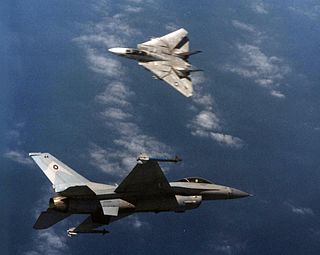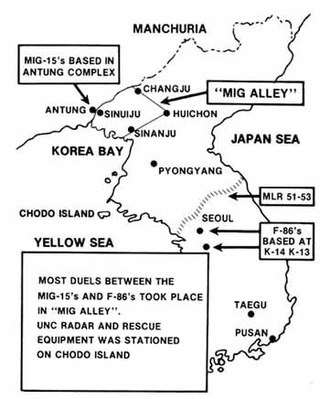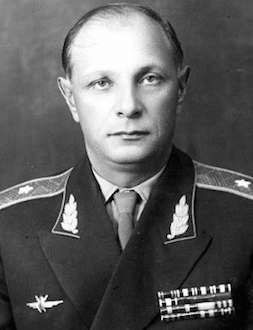
The Mikoyan-Gurevich MiG-15 is a jet fighter aircraft developed by Mikoyan-Gurevich for the Soviet Union. The MiG-15 was one of the first successful jet fighters to incorporate swept wings to achieve high transonic speeds. In aerial combat during the Korean War, it outclassed straight-winged jet day fighters, which were largely relegated to ground-attack roles. In response to the MiG-15's appearance and in order to counter it, the United States Air Force rushed the North American F-86 Sabre to Korea.

USS Lexington (CV/CVA/CVS/CVT/AVT-16) is an Essex-class aircraft carrier built during World War II for the United States Navy. Originally intended to be named Cabot, the new aircraft carrier was renamed while under construction to commemorate the recently-lost USS Lexington (CV-2), becoming the sixth U.S. Navy ship to bear the name in honor of the Battle of Lexington.

John Smith Thach was a World War II Naval Aviator, air combat tactician, and United States Navy admiral. Thach developed the Thach Weave, a combat flight formation which could counter enemy fighters of superior performance, and later the big blue blanket, an aerial defense against kamikaze attacks.

USS San Jacinto (CVL-30) of the United States Navy was an Independence-class light aircraft carrier that served during World War II. She was named for the Battle of San Jacinto during the Texas Revolution. Future U.S. President George H. W. Bush served aboard the ship during World War II.

A dogfight, or dog fight, is an aerial battle between fighter aircraft conducted at close range. Modern terminology for air-to-air combat is air combat manoeuvring (ACM), which refers to tactical situations requiring the use of individual basic fighter maneuvers (BFM) to attack or evade one or more opponents. This differs from aerial warfare, which deals with the strategy involved in planning and executing various missions.

The Grumman F9F Panther is an early carrier-based jet fighter designed and produced by the American aircraft manufacturer Grumman. It was the first jet-powered fighter aircraft operated by the United States Navy as well as being Grumman’s first jet fighter.
This is a list of aviation-related events from 1952:

William Patrick "Willy Irish" Driscoll is a retired commander in the United States Navy and a flying ace. Driscoll, a Naval Flight Officer, and aircrewmate Duke Cunningham, a Naval Aviator, were their service's only aces of the Vietnam War. They remain the Navy's most recently minted aces.

Jesse LeRoy Brown was a United States Navy officer. He was the first African-American aviator to complete the United States Navy's basic flight training program, the first African-American naval officer killed in the Korean War, and a recipient of the Distinguished Flying Cross.

Alexander Vraciu was a United States Navy fighter ace, Navy Cross recipient, and Medal of Honor nominee during World War II. At the end of the war, Vraciu ranked fourth among the U.S. Navy's flying aces, with 19 enemy planes downed during flight and 21 destroyed on the ground. After the war, he served as a test pilot and was instrumental in forming the post-war Naval and Marine Air Reserve program. From 1956 to 1958 Vraciu led his own fighter squadron, VF-51, for twenty-two months. He retired from the U.S. Navy with the rank of commander on December 31, 1963. Vraciu later moved to Danville, California, and worked for Wells Fargo.

"MiG Alley" was the name given by United Nations (UN) pilots during the Korean War to the northwestern portion of North Korea, where the Yalu River empties into the Yellow Sea. It was the site of numerous dogfights between UN fighter pilots and their opponents from North Korea and the People's Republic of China. Soviet-built Mikoyan-Gurevich MiG-15 were the aircraft used during most of the conflict, and the area's nickname was derived from them. It was the site of the first large-scale jet-vs.-jet air battles, with the North American F-86 Sabre.

Thomas Jerome Hudner Jr. was a United States Navy officer and naval aviator. He rose to the rank of captain, and received the Medal of Honor for his actions in trying to save the life of his wingman, Ensign Jesse L. Brown, during the Battle of Chosin Reservoir in the Korean War.

The attack on the Sui-ho Dam was the collective name for a series of mass air attacks during the Korean War on thirteen hydroelectric generating facilities by United Nations Command air forces as part of the North Korean bombing campaign on June 23–24 and June 26–27, 1952. Primarily targeting the hydroelectric complex associated with the Sui-ho Dam in North Korea, the attacks were intended to apply political pressure at the stalled truce negotiations at Panmunjeom.

William Edward Hall was a United States Naval Reserve officer and a recipient of the United States military's highest decoration—the Medal of Honor—for his actions during the Battle of the Coral Sea in World War II.

John Franklin Bolt was a naval aviator in the United States Marine Corps and a decorated flying ace who served during World War II and the Korean War. He remains the only U.S. Marine to achieve ace status in two wars and was also the only Marine jet fighter ace. He rose to the rank of lieutenant colonel during his military career.

Dolphin Dunnaha Overton III was a United States Air Force aviator who became a flying ace during the Korean War. Overton's controversial tour in Korea led to his being removed from combat and denied his medals and victory credits, but he was subsequently reinstated with these.

Colonel Ralph Sherman Parr, Jr. was an American double-flying ace of the Korean War. He was credited with a total of ten downed enemy aircraft. He also flew in World War II and the Vietnam War, and is the only person to have been awarded both the United States Army Distinguished Service Cross and the corresponding decoration used by the United States Air Force once it became an independent branch of service, the Air Force Cross.

Jesse Junior Taylor was a United States Navy naval aviator, Lieutenant Commander during the Vietnam War. He also served as an enlisted man during World War II. He was posthumously awarded the Navy Cross for actions 17 November 1965 over North Vietnam. He was the namesake of USS Taylor.

Stanley Winfield "Swede" Vejtasa was a United States Navy career officer and World War II flying ace. During the Battle of the Santa Cruz Islands, he was credited with downing seven Japanese aircraft in one mission, becoming an "ace in a day".

Sergey Fyodorovich Vishnyakov was a Soviet Air Force officer who fought in World War II and the Korean War, and one of the few pilots considered a flying ace of both wars. He was killed in a flying accident in Bulgaria in 1958.





















